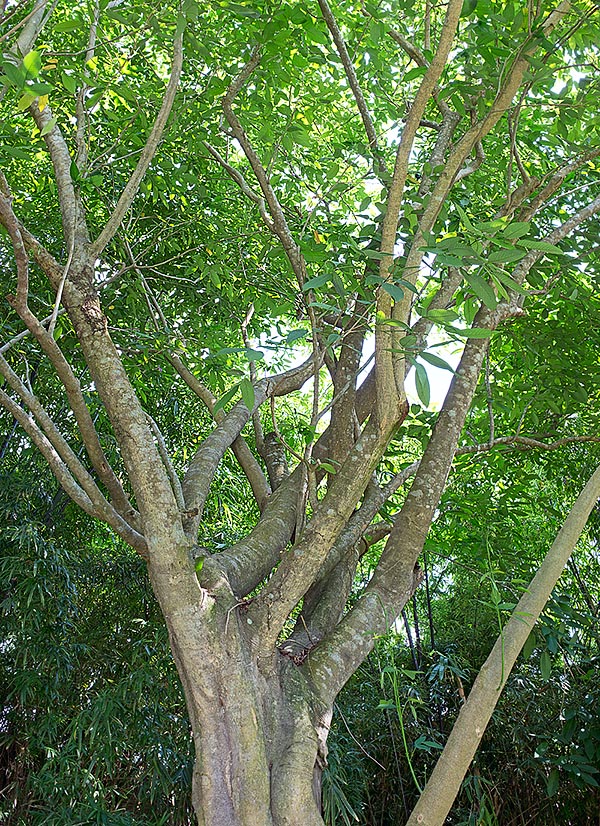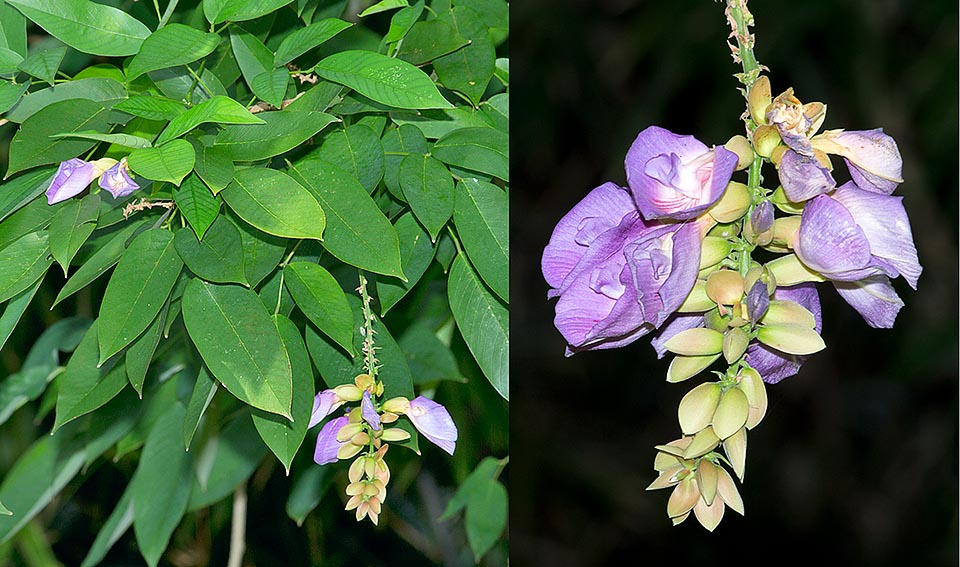Family : Fabaceae

Text © Pietro Puccio

English translation by Mario Beltramini

Clitoria fairchildiana, at home in Brazil, is a tree reaching 12 m of height © Giuseppe Mazza
The name of the genus comes from the Greek substantive “κλειτορίς” (kleitoris) = clitoris, with reference to the look of the flower; the species is honoured to the American botanist David Grandison Fairchild (1869-1954).
Common names: Fairchild pigeonwings, tree clitoria, tree butterfly pea (English); arvore-da-sombra, clitoria-do-amazonas, clitoria-das estradas, faveira, palheteira, sobreiro, sombra-de-vaca, sombreiro (Portuguese-Brazil); barbasco, bohio, carauta, paraguas, sombrero (Spanish).
The Clitoria fairchildiana R.A.Howard (1967) is a deciduous, up to about 12 m tall erect tree, with trunk of 30-50 cm of diameter with wrinkly greyish bark and ample and dense canopy with horizontal or drooping branches; the roots, superficial, present a high number of nodules fixing the atmospheric nitrogen, thus rendering it available also for other plants.
The leaves, on a 3-7 cm long petiole, are alternate, compound, trifoliate, with elliptic-lanceolate to oblong-elliptic leaflets with long pointed apex and entire margin, 8-20 cm long and 3-7 cm broad, coriaceous, glabrous and of glossy intense green colour above, opaque pale green and pubescent below.
Inflorescences racemose axillar or terminal drooping, 8-40 cm long, with numerous fragrant papilionaceous flowers, about 5 cm long and 3 cm broad, of lilac colour with purple longitudinal lines on the standard. The fruit is a brown, woody and flattened legume, 12-30 cm long and 2-3 cm broad, dehiscent when ripe in explosive way, containing 5-10 lenticular black seeds, of 1-1,6 cm of diameter and 1-2 mm of thickness, that are thrown far away.
It reproduces by seed that, if fresh, easily germinates in 2-3 weeks at the temperature of 24-26 °C, otherwise is to be previously scarified and immersed in water for one day in order to accelerate its germination; it can reproduce also by cutting utilizing 30-50 cm long portions, but with a rather low rooting percentage. Fast growing species and easy to cultivate, is utilized, besides Brazil, in various tropical and humid subtropical countries as ornamental and as shade tree in parks and gardens and as road tree; requires an exposition preferably in full sun and draining, fertile, acidic or neutral soils, maintained humid.

Axillar racemose or drooping terminal inflorescences, 8-40 cm long, with several fragrant papilionaceous flowers, about 5 cm long and 3 cm broad. Medicinal virtues © Giuseppe Mazza
Synonyms: Clitoria racemosa Benth. (1837); Ternatea racemosa (G. Don) Kuntze (1891).
→ To appreciate the biodiversity within the family of FABACEAE (alt. Fabaceae) please click here.
